When I first saw a Polka Dot Begonia I knew I wanted to add it to my collected. It’s incredibly unique with it’s fun angel wing style leaves that are covered in white polka dots.
When I discovered it was a low-maintenance plant, I was even more intrigued! And let me tell you, it’s lived up to the claim. This easy to grow plant has become quite the show stopper in my home.
I’m excited to share more about the spotted begonia so you can bring a piece of the Brazilian tropics into your home! If you’re looking for a new plant that will turn heads, this is the perfect option!
Without further ado, let’s check out this ultimate care guide for Begonia Maculata plants.

Table of Contents
Spotted Begonia Background
The Begonia maculata, otherwise more commonly known as the polka dot begonia or the spotted begonia is a peculiar tropical houseplant. It was originally discovered in Brazil in 1982 but it’s originally native to Mexico, Asia, South Africa and Central America.
This beautiful polka dot plant has gained notoriety among home gardeners worldwide for both its fun appearance and low-maintenance care. It’s a cane begonia which means that it has a long bamboo like stems that often times need to be staked up.
As soon as you see one of these plants, you’ll know exactly where it gets its name from! The spotted begonia is identifiable by its unique leaves.
On one side, its deep green leaves are peppered with white and silver polka dots; its underside is a bold red hue. When it’s mature, it blooms bell-shaped white flowers (sometimes they’re red flowers).
It’s sometimes confused with Angel wing begonia (botanical name Begonia x corallina). Angel wing begonias are smaller and the spots are smaller and freckled vs the larger spots for the begonia maculata plant.
Needless to say, a spotted begonia is one indoor plant will turn your guests’ heads. The spotted begonia comes in a range of sizes, depending on the variety but is a fairly fast grower. The larger varieties of polka dot begonia can reach up to 5 feet tall with the right care.
While spotted begonias are slightly toxic, they are not deadly to humans and animals. However, consumption of this plant is known to cause irritation and vomiting. Be sure to keep this plant out of reach from any curious pets or small children.
(If you want cat friendly indoor plants, head here!)
Let’s chat Begonia Maculata care tips and tricks!
Spotted Begonia Care Tips
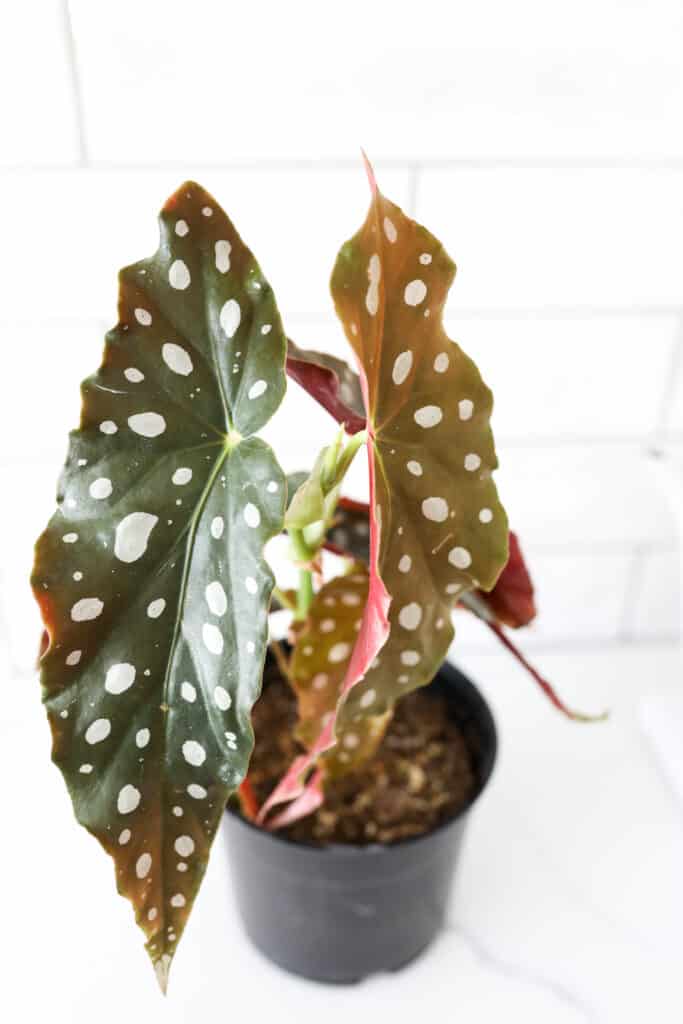
This post includes affiliate links.
Sun & Light
Polka dot begonias require a full day’s worth of bright indirect light to ensure they grow to be healthy and happy. Please avoid placing your begonia in direct bright light, as too much sun can cause severe damage to the plant’s leaves.
I have mine just out of reach of direct sun in a south facing window and my plant thrives there!
If you notice your begonia plants losing color, turning yellow or losing leaves, it’s likely not getting enough light. If you’re plant is looking ill, the main reason is likely that they’re not getting the right light requirements whether that’s too much bright light or not enough light.
If your home doesn’t have a bright spot for your plant you can always use grow lights! This will help you have the right conditions for your plant.
Water
The spotted begonia benefits from moderate watering, but it important to make sure you are not over saturating your soil with water. For best results, allow the first inch of soil to dry before watering again.
In addition, the leaves of the spotted begonia are sensitive to getting wet. To avoid this, try to aim as close to the base of the plant as possible. If water splashes onto the leaves, pat them dry with a towel.
A great way to ensure you’re not overwatering your plant, you can use a moisture meter! You just stick the meter into the soil and it will help you know how much water is in the soil.
Soil Type
Spotted begonias are very forgiving when it comes to soil type. A standard well-draining soil is more than sufficient for your plant. The most important qualities in a begonia soil should be drainage and moisture retention.
As we’ve previously discussed, the spotted begonia enjoys moist soil but not waterlogged soil. To achieve the perfect level of moisture, the soil must have good drainage (and also your pot should have drainage holes). You can amend a regular potting mix with perlite to increase drainage.
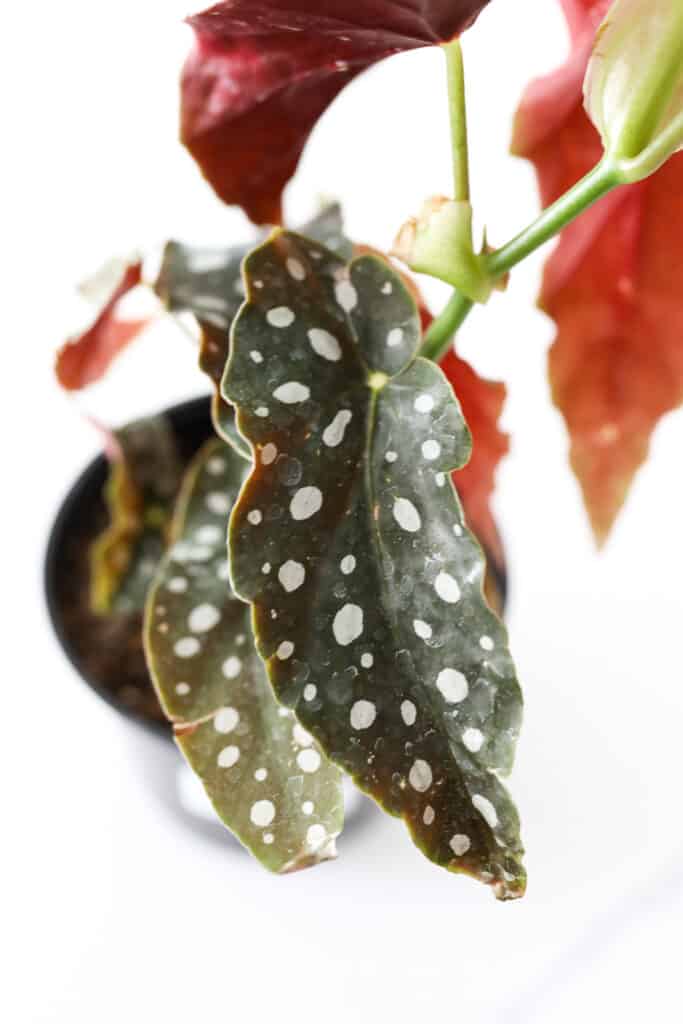
If you want to get really fancy, you can make your own soil with a mixture of sand, clay and loamy soil. This will give it the best moisture retention.
In addition, acidity levels plays a huge role in maintaining a healthy spotted begonia. Aim for a pH level between 6.5 and 7.2, which falls in the slightly acidic range.
Fertilizer
To encourage strong foliage growth in your spotted begonia, I highly recommend including a fertilizer regiment into your care routine. The ideal time to fertilize your plant is during the spring and summer when your plant is in active growth.
Select a liquid plant fertilizer with an equal NPK ratio and dilute the fertilizer with water in a 1:1 ratio. During spring and summer, apply this fertilizer every two to four weeks.
Temperature & Humidity
As a tropical plant, the spotted begonia loves warm, humid environment. The ideal temperature range for your plant is between 65° and 85° F.
Do not allow your temperatures to dip below 55° F; avoid placing your begonia near drafty windows or air conditioning vents where the home temperature tends to be cooler.
It is also important to maintain an environment with high humidity for your plant as well. It is best to use an air humidifier to properly humidify the air for your begonia.
Because they do not enjoy having their leaves wet, please avoid directly misting your plant with water. While a plant mister is often a great alternative for raising humidity levels in your home, it is incompatible with your spotted begonia.
If you don’t want to use a humidifier, you could also put a pebble tray with water under your plant.
Choosing a Pot and Repotting
The most crucial part of selecting a container for your spotted begonia is drainage. The container you house your spotted begonia in should always have at least one drainage hole.
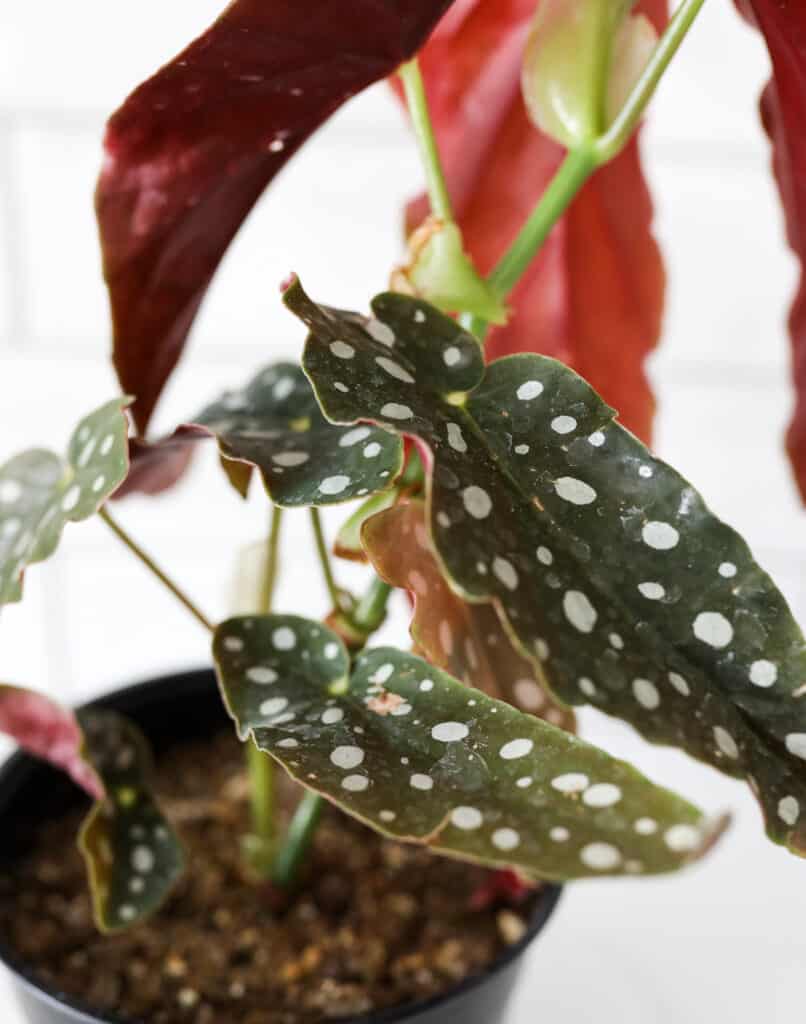
Drainage holes will allow excess water to expel from the soil, preventing the soil from becoming too wet.
Soil that is waterlogged can open your begonia to fungal disease, most notably root rot. In addition, selecting porous materials such as unglazed ceramic and terra cotta add extra drainage to your pot by absorbing unnecessary water.
While the spotted begonia does enjoy being slightly root bound, the overgrowth of roots can deplete soil nutrients. For this reason, it is recommended to repot your begonia yearly.
Size up your pot as gradually as possible, only selecting a pot that is 1 to 2 inches larger than the previous one.
Pruning
Polka dot begonias have a tendency to grow up, rather than out. Because of this, begonias tend to look leggy when they are unkept. By pruning your plant, you can discourage this growth pattern and encourage your plant to grow outwards, giving the appearance of a fuller, bushier plant.
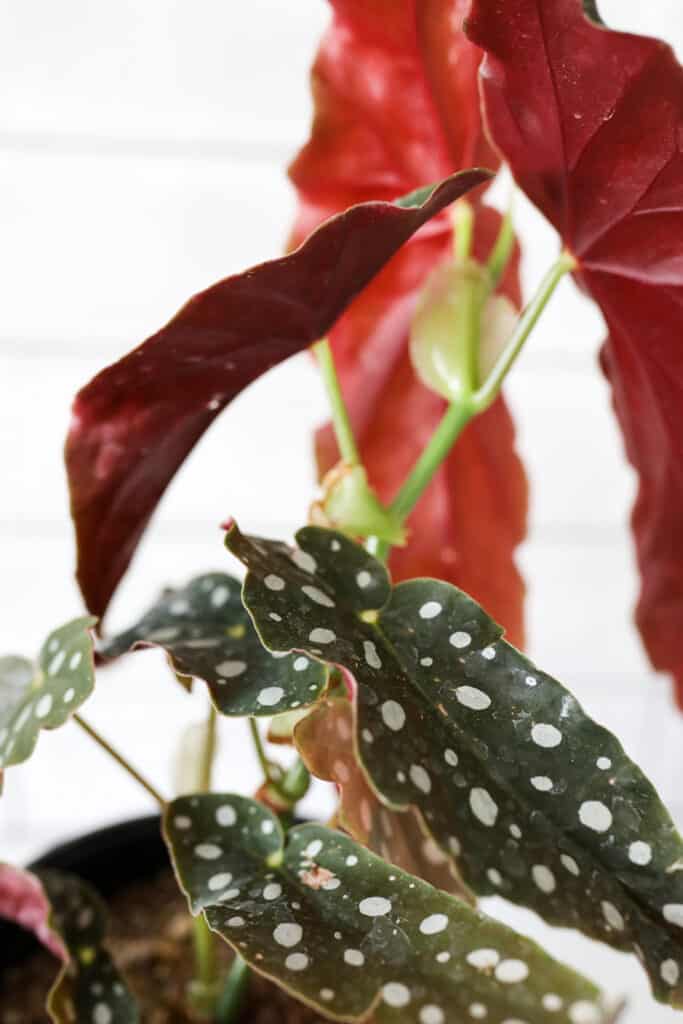
Always start with a pair of sterile, sharp pruning shears. Taking the extra second to dip your shears in rubbing alcohol will effectively reduce the chance of bacterial infection harming your plant. Spotted begonias should be pruned at least twice a year, though it is best to prune once a month.
Begin pruning your begonia by trimming any dead or damaged foliage. By doing this, you are redirecting your plant’s energy towards focusing on developing new, healthy growth, rather than trying to revive damaged leaves that will never recover. If your begonia is getting too tall for your liking, feel free to trim down some leaves.
Don’t be afraid to prune any healthy leaves if you need to trim your plant. These leaves can be repurposed! After pruning your begonia, I recommend using the leftover foliage to propagate your plants.
Let’s find out in the next section how to propagate your spotted begonia.
How to Propagate a Spotted Begonia
Propagating your spotted begonia is simple and straightforward. You can turn one plant into multiple plants with these easy methods.
Like most plants, the best time to propagate a plant is during the growing season. It’s possible to do it in the winter months but you’ll have the most luck during the growing season.
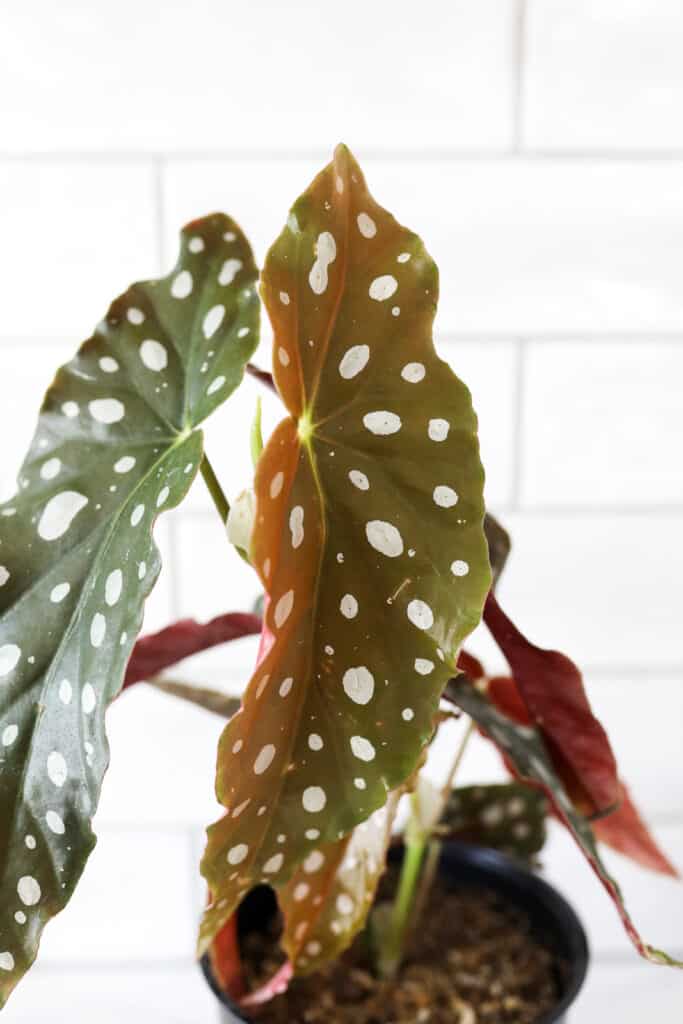
Spotted begonia cuttings can be propagated either via water or soil. These two methods are very similar to one another, with few differences. For both methods, you will need a healthy leaf cutting with no obvious signs of damage
Water Propagation
- Fill a jar with water and place your begonia cutting into the water with the cut-end completely submerged.
- It is best to use a smaller container for water propagation. When you place your stem cuttings into the water, it releases growth hormones, which can become diluted if you use too much water. Also be sure to remove the lower leaves of the stem so they’re not under water.
- Make sure the leaf is above the rim of the jar to allow for air circulation. Proper airflow helps prevent premature rotting.
- Place your jar in a location that receives bright, indirect sunlight.
- Once a week, replenish the water in your jar to help reduce the risk of bacteria prematurely rotting your leaf.
- It can take around four weeks before you see roots forming from the cut-end of the leaf.
- Wait until the roots have grown to at least 1 inch in length before transferring into soil.
Soil Propagation
- Dip the cut-end of the leaf into rooting hormone powder. Rooting hormone powder can be purchased either online or at a plant nursery. It gives your plant’s cutting an extra boost to help it root into the soil.
- Fill a pot with begonia soil and place the stem of the leaf directly into the planter. Once again, make sure that the leaf itself is above ground- this will promote air circulation.
- Care for the cutting as you would with a mature spotted begonia- place in a location with bright, indirect light, and keep the soil evenly moist.
- It takes roughly a month for the cutting to root and become an established plant.
- You can test if the plant has rooted by giving your cutting a gentle tug. If you are met with any resistance, then the cutting has established roots in the soil!
Pests
The spotted begonia is prone to two common household pests: mealybugs and whiteflies. While a pest infestation is one of the last things you want to happen to your plant, these two pests can easily be dealt with by using simple solutions.
Mealybugs are small white pests that congregate around the area where the stem of the leaves meet the main stalk. They suck out the nutrients from your plant and cause detrimental damage.
If you notice a mealybug infestation, prune any afflicted foliage and dispose of them immediately. Treat your plant with either an insecticidal soap or neem oil to exterminate the pest.
Whiteflies are true to their name; they are small, white flies that either buzzes around your plant, or groups underneath your plant’s leaves. These pests can be controlled by laying out yellow fly tape around your plant.
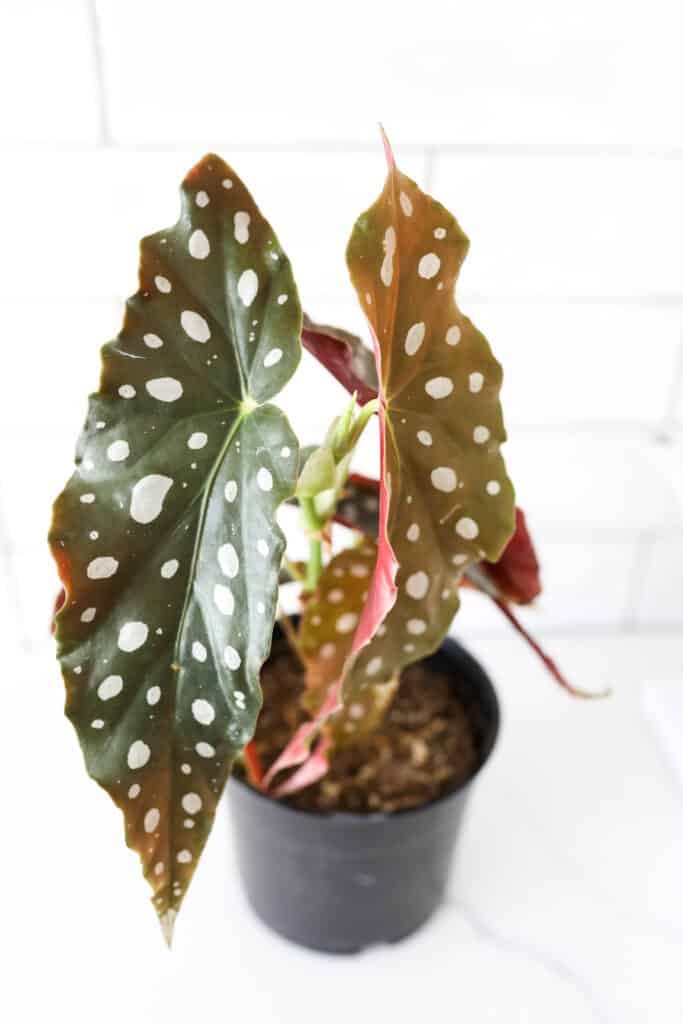
Lay strips of tape on the soil at the base of the plant as well. As a last resort measure, whiteflies can be controlled by spraying your plant with water.
I actually discovered white flies in my plant when I first brought it home. I recommend fully inspecting your plants when you first buy them. The whiteflies in my plant were on the bottom of the pot so hard to detect when I first got it!
Though do keep in mind begonias do not enjoy having their foliage sprayed with water, so exercise caution with this method.
Diseases
We’ve been pretty adamant about how important it is to make sure the spotted begonia is not too wet, as this could open it up to fungal diseases. The two most common diseases associated with the spotted begonia are powdery mildew and root rot.
Both of these diseases are the result of improper handling and can easily be avoided. Of course, accidents happen and with extreme care, you can treat these diseases if they rear their head.
Powdery mildew gets its name from the white powder-like fungus that forms on the plant’s foliage. The cause of powdery mildew is the combination of poor air circulation combined with wet foliage.
If your plant has been affected by powdery mildew, prune any affected foliage and dispose of it immediately. After pruning the affected foliage, treat your plant with a fungicide to eliminate any residual fungus.
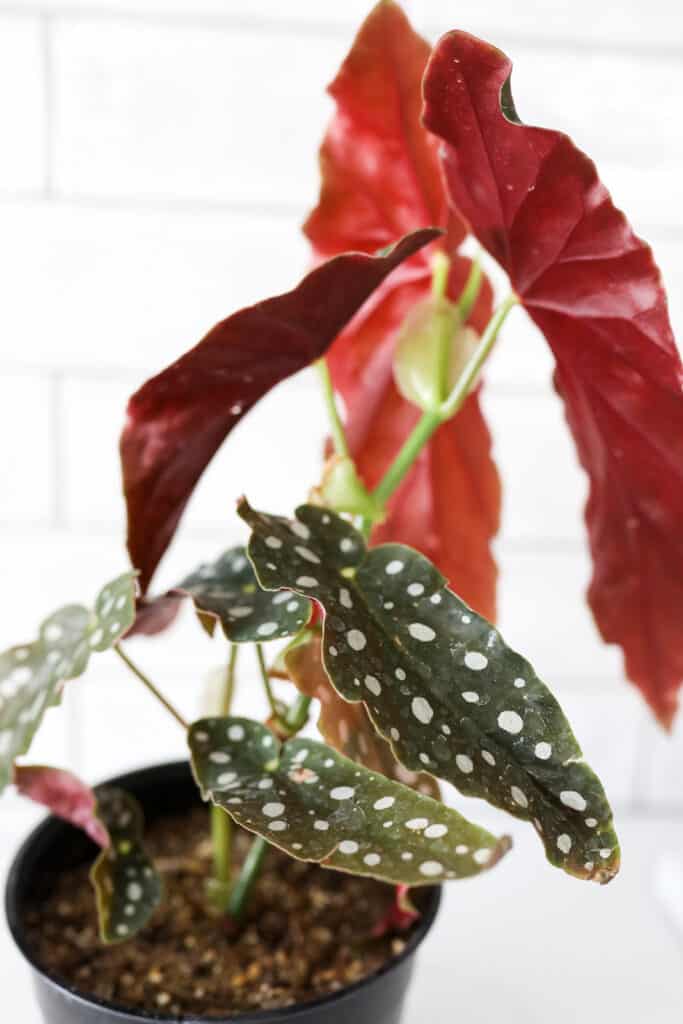
Root rot is another detrimental disease caused by improper watering, but this is more subtle than powdery mildew. Since the disease affects the roots, it’s easy for root rot to happen under your radar until it is too late.
Root rot is the cause of excessive water sitting inside your plant pot, causing the water to break down roots.
If your plant looks like it is dying (drooping, yellow leaves, brown tips), remove the plant from its pot. Rotted roots are dark brown/black in color and feel mushy to the touch.
Take your shears and clip away any dead roots, and repot your plant using fresh soil. Lightly moisten the soil and take intensive care of your plant to ensure that it makes a full recovery.
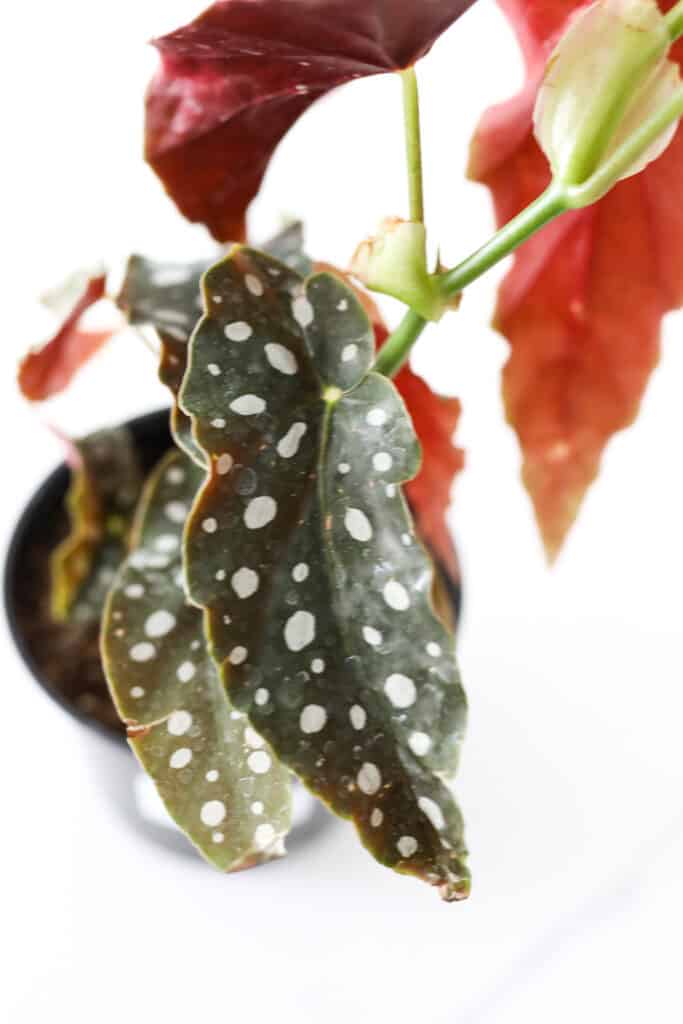
Remember the sooner you detect root rot and powdery mildew, the more likely your plant is to recover from it. Always remember to keep your begonia watered moderately, and avoid wetting the leaves as much as possible.
Where to Buy a Spotted Begonia
You can buy a spotted begonia:
At first sight, one might think the spotted begonia is a haughty tropical plant with lofty care expectations, but this is not the case at all. Yes, the spotted begonia is a gorgeous exotic plant, but it is by no means difficult to care for.
I highly recommend the spotted begonia to gardeners of all skill levels that are looking to bring the tropics indoors.
Looking for more unique plants? Here’s some of the best big leaf plants to check out!

